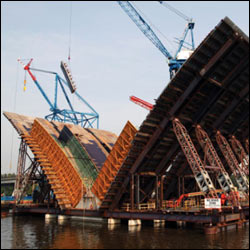















Successes in Stewardship: December 2006 |
|---|

|
Federal Highway Administration
December 2006
Major Projects: A New Challenge in Stewardship

Major Projects are an emerging group of large transportation infrastructure projects with unique requirements. Because of their size and importance within the community, Major Projects require strong oversight on the Federal, state, and local levels in order to gain public trust and to confirm that the project has been a wise investment of public funding. Since the passage of the Safe, Accountable, Flexible, Efficient Transportation Equity Act: A Legacy for Users (SAFETEA-LU), many additional large projects have been designated Major Projects, resulting in more state and Federal oversight.
The Transportation Equity Act for the 21st Century (TEA-21) defined Major Projects as projects with an estimated total cost of over $1 billion, resulting in 21 Major Projects in 13 states. Under SAFETEA-LU the cost threshold for Major Projects was lowered to $500 million. Major Projects now also require Project Management Plans (PMPs) in addition to Financial Plans. Federal Highway Administration (FHWA) has developed interim guidance for project and financial management to clarify the requirements and oversight role for Major Projects.
Major Projects have certain characteristics that distinguish them from the more traditional transportation projects. They are very large, complex, and expensive projects, and their development may span a long period of time. Multiple construction contractors are often used on these projects, which adds another level of complexity. Because of the scale and the likelihood that they will be located in a metropolitan area, Major Projects are often held to high levels of public scrutiny and accountability. The location and expansive nature of many of these projects mean that there may be disruption to the livelihood and traffic flow of the surrounding area. The project sponsor is normally the state transportation agency, but Major Projects may be developed by other state agencies, local jurisdictions, and Public/Private Partnerships.
An example of a Major Project is the new Woodrow Wilson Bridge, a $2.44 billion project located in the Washington, D.C. metropolitan area, spanning a seven-mile corridor on the Capital Beltway (Interstate 95/495) through Maryland and Virginia. The traffic flow from the eight-lane Capital Beltway to the original six-lane bridge exceeded capacity for many years and was considered to be one of the worst bottlenecks in the country. The new bridge project includes a twelve-lane double bridge structure, auxiliary and high occupancy vehicle (HOV) lanes, and four major interchanges reconstructed along the Capital Beltway. Currently, one of the new bridges has been constructed and is in use while the other bridge is under construction.
SAFETEA-LU has resulted in significant changes to the requirements for Major Projects, in addition to having a new definition of a Major Project and requiring a PMP. While Financial Plans were previously required for Major Projects, SAFETEA-LU now requires projects costing $100 to $500 million to have a financial plan, even though they are not considered Major Projects.
New Designation
Since SAFETEA-LU lowered the cost threshold for Major Projects, the number of projects designated as Major Projects has increased. They are now defined as projects receiving Federal financial assistance with a total cost of $500 million or greater, projects selected by the Secretary of Transportation due to a high level of public or congressional attention, projects that require a substantial amount of a state's resources, or projects with extraordinary implications for the national transportation system. An estimated 37 projects in 17 states are now classified as Major Projects, and more than 80 potential Major Projects are currently in the environmental study phase.
Major Projects are taking place throughout the country, with more projects in the planning phase as a result of SAFETEA-LU. Examples include;
Project Management Plans
The new requirement to develop a PMP is intended to function as a "roadmap" by clearly defining the roles, responsibilities, processes, and activities of the Major Project. By taking into account safety and quality considerations, the PMP will assist in delivering the project on time and on budget, while maintaining public trust and confidence.
PMPs will be prepared by the project sponsor and submitted to the FHWA Division Office for approval. Revisions to the PMP can be made any time after approval throughout the project's development.
Financial Plans
Since the enactment of TEA-21, Major Projects have been required to submit annual Financial Plans. The project sponsor prepares and updates financial plans annually and sends the plans to the FHWA Division Office for approval. The Financial Plan must be approved before Federal Aid funds are authorized for project construction. Under SAFETEA-LU, projects with cost estimates between $100 and $500 million are now also required to develop Financial Plans. These projects are not required to submit Financial Plans to FHWA but must make the plans available if requested. FHWA does not formally approve these projects' Financial Plans, but reviews their development as part of the Federal stewardship and oversight process.
In response to the new SAFETEA-LU requirements, FHWA has released several stewardship guidance documents for streamlining Major Project planning. These resources, along with other related documents, are listed on the FHWA Major Projects Website.
Rodney Barry
FHWA Office of Infrastructure
400 Seventh Street, SW
Washington, DC 20590
rodney.barry@fhwa.dot.gov
Phone: 202-366-1561
"Successes in Stewardship" is a Federal Highway Administration newsletter highlighting current environmental streamlining and stewardship practices from around the country. To subscribe, visit the Registration Site, or call 617-494-3137. |
